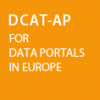General Information

Name of the solution: DCAT-AP
Solution's owner: European Commission, Europe
Description: The DCAT Application Profile for data portals in Europe (DCAT-AP) is a specification based on the Data Catalogue Vocabulary (DCAT) developed by W3C. This application profile is a specification for metadata records to meet the specific application needs of data portals in Europe while providing semantic interoperability with other applications on the basis of reuse of established controlled vocabularies (e.g. EuroVoc) and mappings to existing metadata vocabularies
Type of solution: Semantic asset
DCAT-AP implements the following:
| Principles | Interoperability layers | Conceptual model |
|---|---|---|
| ✅ Openness | ✅ Semantic interoperability | ✅ Open data |
| ✅ Transparency | ✅ Catalogues | |
| ✅ User-centricity | ||
| ✅ Technological neutrality | ||
| ✅ Reusability |
DCAT-AP implements the following recommendations as explained below:
✅ Recommendation 4 | Principle 2: Openness
DCAT-AP is a solution that is based on open specifications and it is actively maintained by a community of developers.
✅ Recommendation 5 | Principle 3: Transparency
The DCAT-AP for data portals allows the sharing of data and interconnection between national data portals and also with the EU data portal, hence ensuring external visibility of resources.
✅ Recommendation 6 | Principle 4: Reusability
DCAT-AP is available for anyone's reuse as it is based on open specifications and it in itself facilitates the sharing of data.
✅ Recommendation 7 | Principle 4: Reusability
DCAT-AP facilitates the sharing of data, by making it more easily shareable and accessible.
✅ Recommendation 8 | Principle 5: Technological neutrality
DCAT-AP allows data catalogues to describe their dataset collections using a standardised description, while keeping their own system for documenting and storing them, hence ensuring technological neutrality.
✅ Recommendation 9 | Principle 5: Technological neutrality
DCAT-AP ensures data portability by providing an application profile for interconnection between data portals in Europe and with the European data portal.
✅ Recommendation 11 | Principle 6: User-centricity
Content aggregators, such as the European Data Portal can use DCAT-AP it easily aggregate data descriptions into a single point of access.
✅ Recommendation 12 | Principle 6: User-centricity
DCAT-AP specifications are determined by a list of stakeholders following an open procedure.
✅ Recommendation 30 | Interoperability layer: Semantic interoperability
DCAT-AP contributes to the perception of data as a public asset by enabling the exchange of descriptions of datasets (metadata) among data portals. This facilitates the search and identification of relevant data for one's needs.
✅ Recommendation 31 | Interoperability layer: Semantic interoperability
DCAT-AP provides a European standard for metadata publishing.
✅ Recommendation 39 | Conceptual model: Base registries
DCAPT-AP enables the sharing of metadata between different data portals by providing a specification to describe such data in a standardised way, hence ensuring interoperability.
✅ Recommendation 42 | Conceptual model: Open data
DCAT-AP provides a non-proprietary specification for describing public sector datasets in Europe to enable the exchange of descriptions of datasets (metadata).
✅ Recommendation 44 | Conceptual model: Catalogues
DCAT-AP allows data catalogues to describe their dataset collections using a standardised description.

